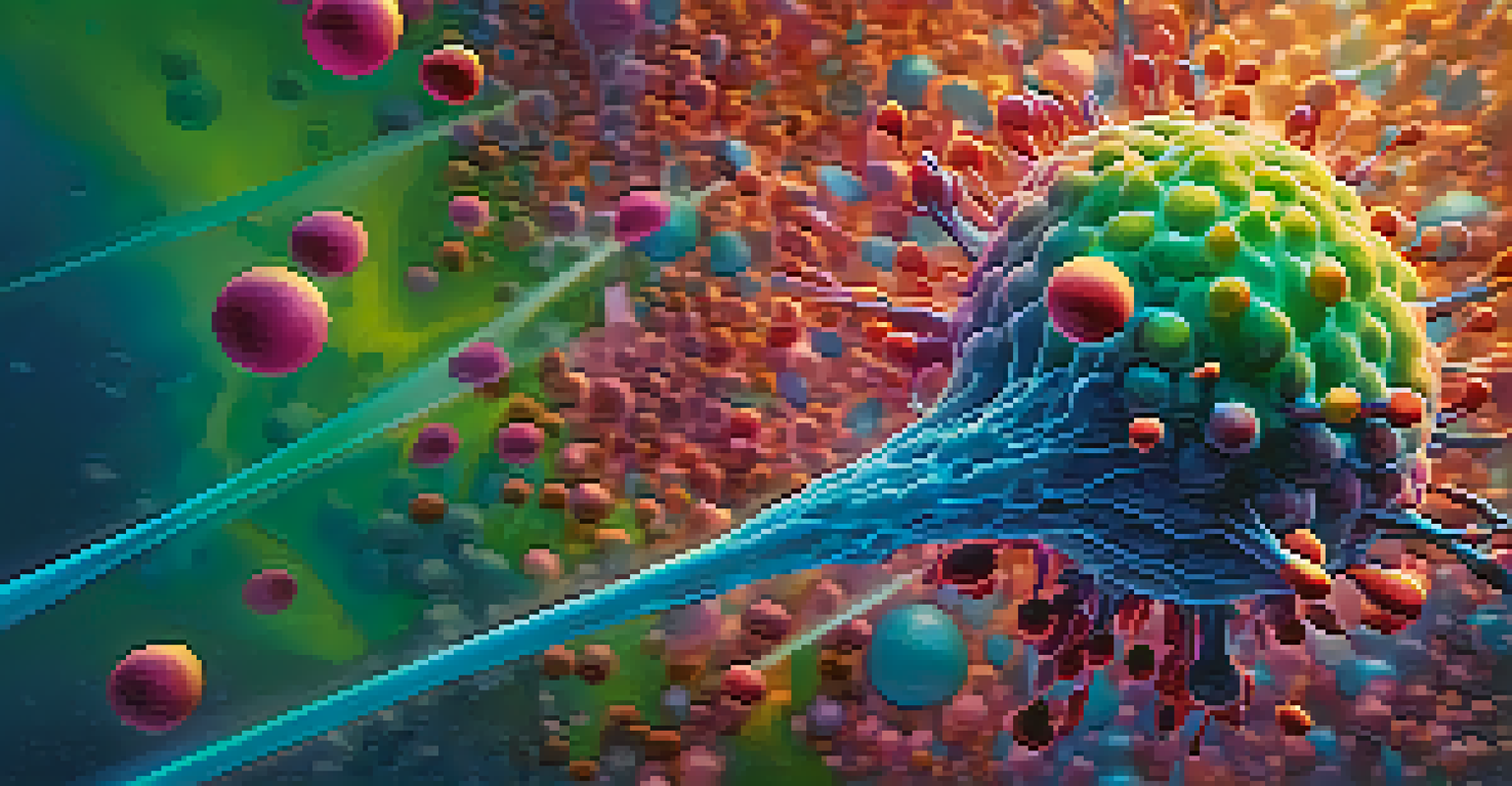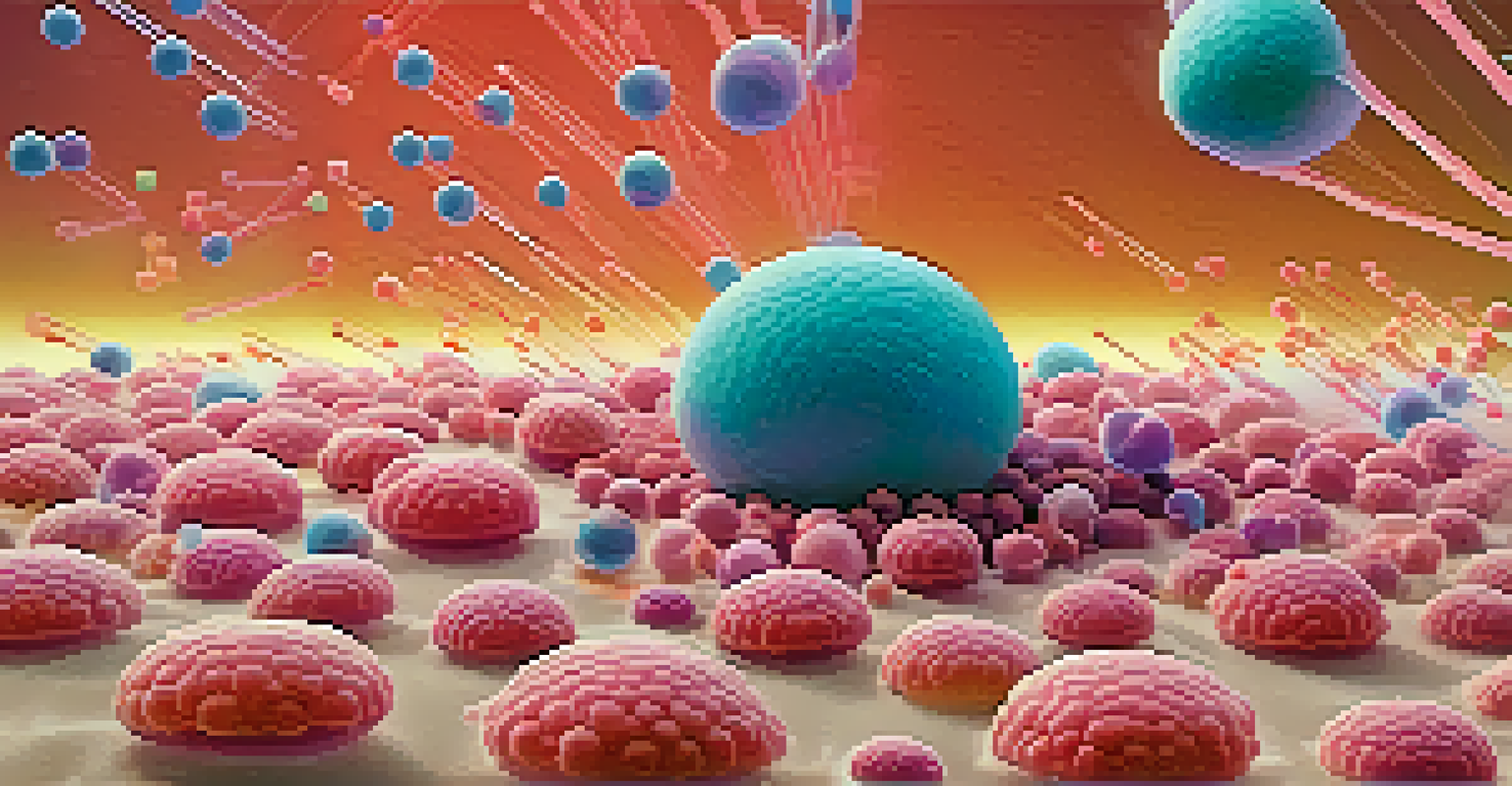Nanoparticle-Based Drug Delivery Systems for Targeted Therapy

Understanding Nanoparticles and Their Role in Medicine
Nanoparticles are tiny particles, typically ranging from 1 to 100 nanometers in size. Their small size allows them to interact with biological systems at the cellular level, making them invaluable in medical applications. In drug delivery, these particles can encapsulate medications and transport them directly to targeted cells, improving the efficacy and reducing side effects.
Nanotechnology is the future of all technologies.
Imagine nanoparticles as tiny delivery trucks, expertly navigating through the bloodstream to deliver essential packages – in this case, therapeutic drugs. This targeted approach means that rather than affecting the entire body, the treatment can home in on specific areas, like tumors, which is particularly useful in cancer therapy. This precision helps maximize the drug's impact while minimizing damage to healthy tissues.
The versatility of nanoparticles is noteworthy; they can be made from various materials, including lipids, polymers, and metals. Each type has its unique properties, allowing researchers to tailor them for specific therapeutic needs. As science continues to evolve, the potential applications for these tiny powerhouses in medicine seem limitless.
Advantages of Nanoparticle-Based Drug Delivery Systems
One of the most significant advantages of nanoparticle systems is their ability to improve drug solubility and stability. Many medications have poor solubility in water, limiting their effectiveness. By encapsulating these drugs within nanoparticles, scientists can enhance their solubility, allowing for better absorption in the body, which translates to improved therapeutic outcomes.

Moreover, these systems can be designed for controlled and sustained release of drugs. Think of it as a time-release capsule that gradually delivers medication over time rather than all at once. This controlled release can help maintain optimal drug levels in the bloodstream, providing more consistent treatment and reducing the frequency of dosages.
Nanoparticles Enhance Drug Delivery
These tiny particles improve drug solubility and enable targeted delivery, maximizing therapeutic effects while minimizing side effects.
Additionally, targeted delivery via nanoparticles can significantly reduce side effects. Traditional treatments often affect healthy cells along with the targeted ones, leading to unpleasant side effects. However, by directing the drug specifically to the intended site, nanoparticles can help spare healthy tissues, making treatments more tolerable for patients.
Challenges in Developing Nanoparticle Drug Delivery Systems
Despite their potential, developing nanoparticle-based drug delivery systems is not without challenges. One major hurdle is the scaling-up process; while lab tests may show promise, translating these experiments into large-scale production can be complex and costly. Ensuring that nanoparticles maintain their effectiveness and stability during production is crucial.
The greatest discoveries of the 21st century will come from the intersection of biology and technology.
Another challenge lies in the regulatory landscape. Since nanoparticles are often classified as new drug entities, they face rigorous testing and approval processes before they can reach the market. This lengthy approval process can delay the availability of potentially life-saving treatments for patients who need them.
Lastly, there is the issue of biocompatibility. Not all nanoparticles are harmless; some can trigger immune responses or toxicity in the body. Researchers must conduct extensive studies to understand how these particles interact with biological systems to ensure that they are safe for human use.
Nanoparticles in Cancer Therapy: A Game Changer
Cancer therapy has been one of the most promising fields for nanoparticle applications. Traditional chemotherapy often involves high doses that affect healthy cells, leading to severe side effects. Nanoparticle-based delivery systems can target cancer cells more precisely, delivering higher concentrations of the drug directly to the tumor while sparing healthy tissue.
For instance, certain nanoparticles can be designed to respond to the tumor's unique environment, such as its pH or temperature. Once they reach the tumor site, they can release their drug payload in a controlled manner, enhancing the treatment's effectiveness. This targeted approach not only improves the therapeutic impact but also reduces the overall burden of treatment on the patient.
Challenges in Nanoparticle Development
Despite their potential, the development of nanoparticle drug delivery systems faces hurdles such as scalability, regulation, and biocompatibility.
Clinical trials have shown that nanoparticle-based therapies can lead to better outcomes in terms of tumor reduction and patient quality of life. As research continues to advance in this exciting area, we may soon see even more innovative cancer treatments that harness the power of nanoparticles.
The Role of Nanoparticles in Treating Infectious Diseases
Nanoparticles are also making waves in the fight against infectious diseases. They can enhance the delivery of antibiotics, antiviral medications, and vaccines, improving their effectiveness. For example, nanoparticles can be used to encapsulate vaccines, ensuring they are delivered more efficiently to the immune system.
Additionally, some studies suggest that nanoparticles can help combat antibiotic resistance. By delivering drugs directly to the site of infection in a more concentrated form, they can overcome some of the challenges posed by bacteria that have developed resistance to standard treatments. This targeted approach could be a crucial tool in addressing the growing concern of resistant pathogens.
Moreover, nanoparticles can be engineered to include therapeutic agents that not only target pathogens but also stimulate the immune response. This dual-action approach could enhance the body’s natural defenses, making it easier to fight off infections while also reducing the need for high doses of medication.
Future Prospects of Nanoparticle-Based Drug Delivery Systems
The future of nanoparticle-based drug delivery systems is incredibly promising. As technology advances, we can expect nanoparticles to become even more sophisticated, capable of delivering multiple drugs simultaneously or targeting multiple sites within the body. This multi-faceted approach could revolutionize the way we treat complex diseases like cancer and chronic conditions.
Researchers are also exploring the use of nanoparticles for gene therapy. By encapsulating therapeutic genes within nanoparticles, scientists hope to deliver genetic material directly to the cells that need it, potentially correcting genetic disorders at their source. This could open new avenues for treating diseases that currently have no cure.
Future of Cancer and Gene Therapy
Nanoparticles are poised to revolutionize treatments for complex diseases like cancer and genetic disorders through targeted and personalized approaches.
Moreover, with the rise of personalized medicine, nanoparticles could be tailored to individual patient profiles. By analyzing a patient’s unique genetic makeup, practitioners could customize nanoparticle treatments that optimize efficacy and minimize side effects. The integration of nanoparticles into personalized medicine could significantly enhance treatment outcomes.
Conclusion: The Potential of Nanoparticle Drug Delivery
In conclusion, nanoparticle-based drug delivery systems hold remarkable potential for transforming the landscape of modern medicine. Their ability to enhance drug solubility, provide targeted delivery, and minimize side effects makes them a promising option for various therapeutic applications. As research continues to unfold, we are likely to uncover even more benefits and applications of this innovative technology.
However, addressing the challenges of development, regulation, and biocompatibility remains essential to realize their full potential. The journey from the lab to the clinic is often long and complex, but the rewards can be life-changing for patients with conditions that currently have limited treatment options.

As we look to the future, the continued exploration of nanoparticles in medicine could lead to groundbreaking therapies that not only improve patient outcomes but also redefine how we approach disease treatment and management.